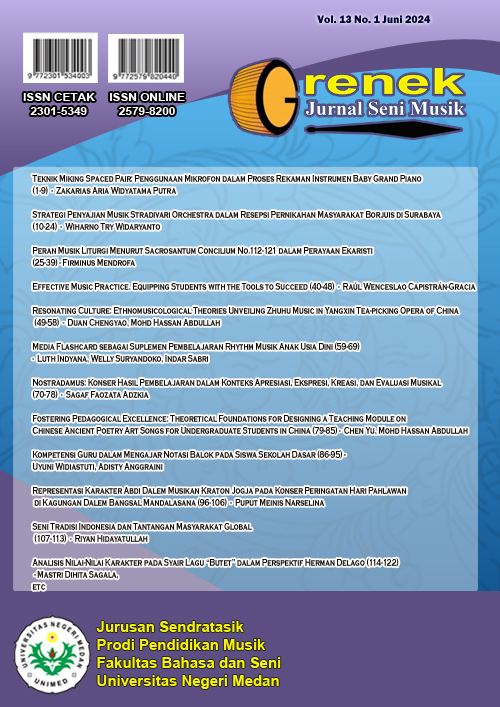Fostering Pedagogical Excellence: Theoretical Foundations for Designing a Teaching Module on Chinese Ancient Poetry Art Songs for Undergraduate Students in China
Main Article Content
Abstract
Article Details

This work is licensed under a Creative Commons Attribution-ShareAlike 4.0 International License.
Authors published with the Grenek: Jurnal Seni Musik agree to the following terms:
- Authors retain copyright and grant the journal the right of first publication with the work simultaneously licensed under a Creative Commons Attribution License (CC BY-SA 4.0) that allows others to share the work with an acknowledgment of the work's authorship and initial publication in this journal.
- Authors are able to enter into separate, additional contractual arrangements for the non-exclusive distribution of the journal's published version of the work (e.g., post it to an institutional repository or publish it in a book), with an acknowledgment of its initial publication in this journal.
- Authors are permitted and encouraged to post their work online (e.g., in institutional repositories or on their website) prior to and during the submission process, as it can lead to productive exchanges, as well as earlier and greater citation of published work. (See The Effect of Open Access)
References
Armstrong, T. (2009). Multiple Intelligences in the Classroom (3rd ed.). ASCD.
Campbell, L., Campbell, B., & Dickinson, D. (2004). Teaching and Learning Through Multiple Intelligences (3rd ed.). Allyn & Bacon.
Creemers, B. P., et al. (2012). The advantages of teaching modules over traditional topic-
based teaching. Educational Psychology Review, 24(3), 483-497.
Gardner, H. (1983). Frames of Mind: The Theory of Multiple Intelligences. Basic Books.
Gardner, H. (1999). Intelligence Reframed: Multiple Intelligences for the 21st Century. Basic Books.
Kornhaber, M. L., Fierros, E. G., & Veenema, S. (2004). Multiple Intelligences: Best Ideas from Research and Practice. Allyn & Bacon.
Ries, E. (2016). Teaching modules: A conceptual framework. Journal of Education, 30(2), 45-58.
Shi Yujian & Xu Ying. (2020). Teaching module model for junior high English. English Teaching Research, 18(1), 56-70.
Sternberg, R. J., & Grigorenko, E. L. (2002). The Theory of Successful Intelligence. Review of General Psychology, 6(4), 316“342. DOI: https://doi.org/10.1177/001698620204600403
Wang Honglei. (2022). A model for a "live-streaming marketing course." Journal of Marketing Education, 36(2), 132-148.
Zhang Yibin. (2011). Model for teaching module development. Journal of Curriculum Studies, 15(2), 78-92.
Zhao Jiajia. (2018). Development of teaching modules for environmental art design. Journal of Art Education, 40(4), 215-230.
